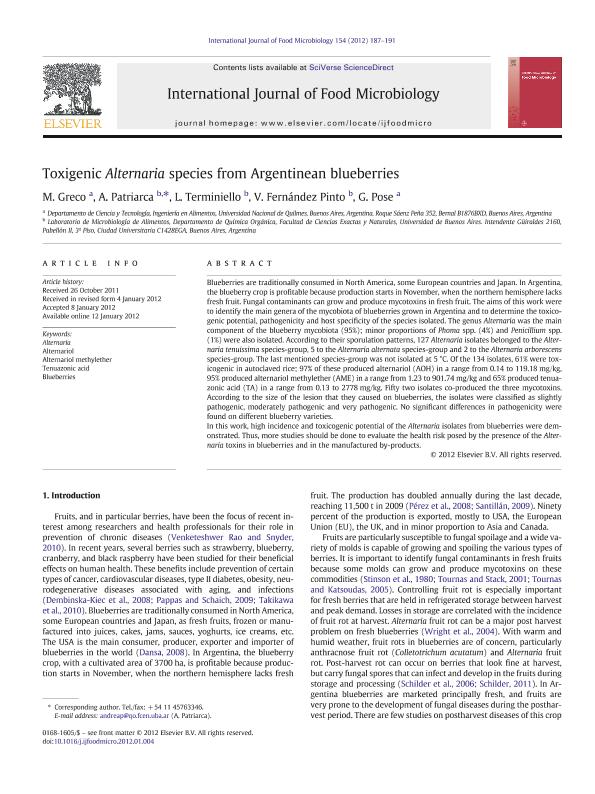Artículo
Toxigenic Alternaria species from Argentinean blueberries
Greco, Mariana Vanesa ; Patriarca, A.; Terminiello, Laura Adriana; Fernández Pinto, Virginia Elena; Pose, Graciela Noemi
; Patriarca, A.; Terminiello, Laura Adriana; Fernández Pinto, Virginia Elena; Pose, Graciela Noemi
 ; Patriarca, A.; Terminiello, Laura Adriana; Fernández Pinto, Virginia Elena; Pose, Graciela Noemi
; Patriarca, A.; Terminiello, Laura Adriana; Fernández Pinto, Virginia Elena; Pose, Graciela Noemi
Fecha de publicación:
01/2012
Editorial:
Elsevier Science
Revista:
International Journal of Food Microbiology
ISSN:
0168-1605
Idioma:
Inglés
Tipo de recurso:
Artículo publicado
Clasificación temática:
Resumen
Blueberries are traditionally consumed in North America, some European countries and Japan. In Argentina, the blueberry crop is profitable because production starts in November, when the northern hemisphere lacks fresh fruit. Fungal contaminants can grow and produce mycotoxins in fresh fruit. The aims of this work were to identify the main genera of the mycobiota of blueberries grown in Argentina and to determine the toxicogenic potential, pathogenicity and host specificity of the species isolated. The genus Alternaria was the main component of the blueberry mycobiota (95%); minor proportions of Phoma spp. (4%) and Penicillium spp. (1%) were also isolated. According to their sporulation patterns, 127 Alternaria isolates belonged to the Alternaria tenuissima species-group, 5 to the Alternaria alternata species-group and 2 to the Alternaria arborescens species-group. The last mentioned species-group was not isolated at 5. °C. Of the 134 isolates, 61% were toxicogenic in autoclaved rice; 97% of these produced alternariol (AOH) in a range from 0.14 to 119.18. mg/kg, 95% produced alternariol methylether (AME) in a range from 1.23 to 901.74. mg/kg and 65% produced tenuazonic acid (TA) in a range from 0.13 to 2778. mg/kg. Fifty two isolates co-produced the three mycotoxins. According to the size of the lesion that they caused on blueberries, the isolates were classified as slightly pathogenic, moderately pathogenic and very pathogenic. No significant differences in pathogenicity were found on different blueberry varieties.In this work, high incidence and toxicogenic potential of the Alternaria isolates from blueberries were demonstrated. Thus, more studies should be done to evaluate the health risk posed by the presence of the Alternaria toxins in blueberries and in the manufactured by-products.
Palabras clave:
ALTERNARIA
,
ALTERNARIOL
,
ALTERNARIOL METHYLETHER
,
BLUEBERRIES
,
TENUAZONIC ACID
Archivos asociados
Licencia
Identificadores
Colecciones
Articulos(SEDE CENTRAL)
Articulos de SEDE CENTRAL
Articulos de SEDE CENTRAL
Citación
Greco, Mariana Vanesa; Patriarca, A.; Terminiello, Laura Adriana; Fernández Pinto, Virginia Elena; Pose, Graciela Noemi; Toxigenic Alternaria species from Argentinean blueberries; Elsevier Science; International Journal of Food Microbiology; 154; 3; 1-2012; 187-191
Compartir
Altmétricas



